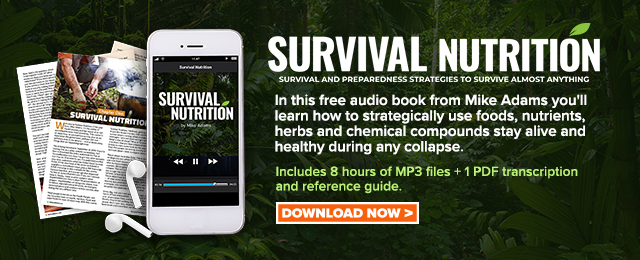
Supersize your body with restaurant entrees
Friday, June 08, 2012 by: J. D. Heyes
Tags: restaurant, food, calories
- Aerosolized bioweapons? Strange “diploid biomasses” falling out of the sky in Florida captured under the microscope
- Widespread social and economic unrest: Steve Quayle issues urgent financial warning of imminent asset collapse in new interview with Mike Adams
- Israeli lobbyists boast of controlling US national security policy in leaked AIPAC audio
- U.S. lawmakers investigate Meta over alleged China collaboration
- Analysis: The coming economic collapse, a mass uprising and Trump's three secret weapons to halt the growing revolt
- Kiss Your Genetic Privacy Good-Bye! 23andMe Gets Green Light to Sell Your Intimate Genetic Details to Anyone They Want
- Fauci is back in the limelight, and he’s busy promoting a future COVID or FLU pandemic
- Mike Adams releases country western hit single: Goin’ Back in Time is Comin’ Home
- Warp Speed 2.0: Trump Administration ACCELERATES Gates-funded, self-amplifying bird flu vaccines
- TAKE IT DOWN Act advances in Congress amid free speech concerns
- CLOT SHOT PLANDEMIC UNFOLDING: Fibrous, rubbery clots caused by covid injections have prion-like seeding activity
- DMSO and Natural Dyes: A suppressed cancer treatment resurfaces in independent research
- Tulsi Gabbard leads charge against the Biden regime’s global censorship of the 'Disinformation Dozen'
- Curcumin’s ancient healing power supercharges muscle recovery, and its effects are compounded with anti-inflammatory foods and supplements
- Father speaks out: Challenging the mainstream narrative of his daughter’s “unvaccinated measles death”
- Defunding DEADLY mRNA jabs: Government funding for mRNA technology being scrutinized and sidelined until proven "safe and effective" for real
- Pfizer's RSV vaccine linked to preterm births as drug giant CONCEALED RISKS from pregnant women in unethical clinical trials
- Chemical cocktails in processed foods linked to diabetes, validating natural health warnings
- Aerosolized bioweapons? Strange “diploid biomasses” falling out of the sky in Florida captured under the microscope
- Fauci is back in the limelight, and he’s busy promoting a future COVID or FLU pandemic
- Tulsi Gabbard leads charge against the Biden regime’s global censorship of the 'Disinformation Dozen'
- Analysis: The coming economic collapse, a mass uprising and Trump's three secret weapons to halt the growing revolt
- Widespread social and economic unrest: Steve Quayle issues urgent financial warning of imminent asset collapse in new interview with Mike Adams
- Kiss Your Genetic Privacy Good-Bye! 23andMe Gets Green Light to Sell Your Intimate Genetic Details to Anyone They Want
- U.S. lawmakers investigate Meta over alleged China collaboration
- Mike Adams releases country western hit single: Goin’ Back in Time is Comin’ Home
- Israeli lobbyists boast of controlling US national security policy in leaked AIPAC audio
- Chemtrails unveiled: How the CIA and Big Business are manipulating the weather for profit
- Curcumin’s ancient healing power supercharges muscle recovery, and its effects are compounded with anti-inflammatory foods and supplements
- CLOT SHOT PLANDEMIC UNFOLDING: Fibrous, rubbery clots caused by covid injections have prion-like seeding activity
- China’s counter-tariff strategies: A new chapter in the U.S.-China trade war
- Pfizer's RSV vaccine linked to preterm births as drug giant CONCEALED RISKS from pregnant women in unethical clinical trials
- Shedding light on the dark side of MMR vaccines: How vaccinated individuals SPREAD MEASLES & put the vulnerable at risk
- Dane Wigington exposes climate engineering as ‘All-Out Weather and Biological Warfare’
- Defunding DEADLY mRNA jabs: Government funding for mRNA technology being scrutinized and sidelined until proven "safe and effective" for real
- DEATH by VACCINE or face PRISON time: Canadian Freedom Convoy leaders CONVICTED for protesting forced vaccination during the Covid Plandemic
- Newly released JFK files reveal Pentagon's role in creating Lyme disease and covid in the same lab
- Analysis: The coming economic collapse, a mass uprising and Trump's three secret weapons to halt the growing revolt
- Mike Adams releases country western hit single: Goin’ Back in Time is Comin’ Home
- Aerosolized bioweapons? Strange “diploid biomasses” falling out of the sky in Florida captured under the microscope
- Kiss Your Genetic Privacy Good-Bye! 23andMe Gets Green Light to Sell Your Intimate Genetic Details to Anyone They Want
- European Court of Justice: Healthcare professionals who promoted or administered COVID-19 vaccines are CRIMINALLY LIABLE for any harm caused
- Federal employees whine over DOGE's new directive requiring them to do a 5-point summary of weekly accomplishments
- U.S. approves new Russian ambassador as diplomatic thaw continues
- Government waste exposed: Hegseth supports Musk’s demand for accountability from federal workers
- Now you can HEAR chemistry: Health Ranger translates molecules into music in stunning video demonstration that will blow your mind (and your ears)
- Widespread social and economic unrest: Steve Quayle issues urgent financial warning of imminent asset collapse in new interview with Mike Adams
- Dr. Mike Yeadon releases 15-minute testimony - WATCH - about genocidal intent of COVID “vaccines”
- The Health Ranger releases “Vaccine Zombie” song and music video, using AI-animated zombies for the music video
- Trump reverses course on Gaza plan, says “nobody is expelling Palestinians”
- EPA advisor admits the agency is funneling billions to climate groups ahead of Trump’s return to White House
- 5 Simple steps to boost your brainpower: How to strengthen executive function in a distracted world
- I Want My Bailout Money – new song and music video released by Mike Adams
- Tulsi Gabbard leads charge against the Biden regime’s global censorship of the 'Disinformation Dozen'
- Red Cross issues warning to stop blood plasma donations from vaccinated people
- Scientists confirm: GENIUS brain function can be spontaneously unleashed in humans without any apparent cause
- EPA advisor admits the agency is funneling billions to climate groups ahead of Trump’s return to White House
- HYSSOP: What research reveals about the health benefits of this ancient holy herb
- Two containers with completed ballots fall out of truck in Florida
- Newly released JFK files reveal Pentagon's role in creating Lyme disease and covid in the same lab
- Global leaders unite to clamp down on “misinformation” with UN-backed Cascais Declaration
- BREAKING: 2025 NDAA authorizes mandatory military draft of WOMEN across America… as Pentagon pursues global NUCLEAR war with both Russia and China at the same time
- Mike Adams releases country western hit single: Goin’ Back in Time is Comin’ Home
- Michael Yon warns of a ZIONIST TAKEOVER in Trump’s second administration
- Ozempic and Wegovy weight loss drugs are injectable LIZARD VENOM PEPTIDES that may unleash a devastating wave of organ failure… side effects align with symptoms of SNAKE BITES
- The Health Ranger releases “Vaccine Zombie” song and music video, using AI-animated zombies for the music video
- BOMBSHELL: DNA testing kits are a SCAM to develop ethnic-specific bioweapons
- Israeli soldiers accused of even more torture and abuse in the West Bank
- These 13 countries just signed an agreement to engineer a global FAMINE by destroying food supply
- I Want My Bailout Money – new song released by Mike Adams
- NASA admits that climate change occurs because of changes in Earth’s solar orbit, and NOT because of SUVs and fossil fuels
- RFK Jr. clears key hurdle: Sen. Susan Collins backs controversial HHS nominee, signaling a new era for health policy
It's long been known that restaurant portions are larger than most nutritionists would advise, but a new study says it may be worse than thought, according to a new study. According to research conducted by the RAND Corporation, a staggering 96 percent of the chain restaurants examined serve larger-than-recommended portions, with the majority of main entrees falling below one-third of the Department of Agriculture's (USDA) estimated daily energy needs.
"If you're eating out tonight, your chances of finding an entree that's truly healthy are painfully low," said lead researcher Helen Wu, assistant policy analyst at RAND, in an interview with USA Today.
Wu and her research team, which published their results in the journal Public Health Nutrition, looked at 28,433 regular menu items and 1,833 children's menus at 245 restaurant chains around the nation between February and May 2010. The team then looked at USDA recommendations for the maximum daily allowances of calories, fat, saturated fat and sodium, and then divided those figures by three to get the government's recommendation for a single meal.
The majority of the dishes fell below the USDA's 667-calorie limit for a meal. But they also fell short of the requirements for sodium, fat and saturated fat; according to Uncle Sam, those should not exceed 767 mg per meal.
Misleading healthy food strategies?
The restaurant industry says it's doing what it can to help consumers make healthier choices. Eateries are "employing a wide range" of strategies to assist diners, says Joan McGlockton, vice president of food policy at the National Restaurant Association."Among them: putting nutritional information on menus, adding more healthful items and launching a 2011 program at nearly 100 brands in more than 25,000 locations that offers children's meals in line with 2010 dietary guidelines," USA Today reported.
But those strategies can be misleading, says Wu.
"Many items may appear healthy based on calories, but actually can be very unhealthy when you consider other important nutrition criteria," Wu said in a separate interview with the Los Angeles Times.
Do you like those deep-fried mushrooms and breaded cheese sticks? Well, one of the worst menu items, according to the study, is the appetizer, a food item that many people often eat as their main course. They are stuffed with calories, averaging 813 calories apiece as compared to the 667-calorie main entree. Chicken wings with dip were big belly busters. "I'm not ordering chicken wings anymore," Wu told the Times.
Also, so-called family restaurants are worse, even, than fast-food places, if you can believe that. The study found entrees at family restaurants, on average, contained more calories, fat and sodium than fast-food eateries. In fact, entrees at family-style eateries posted 271 more calories, 435 more milligrams of sodium and 16 more grams of fat than fast-food places, Wu said.
The study also found that kids' "specialty" drinks also pack in the calories. In fact, many specialty drinks on the kid's menu have more calories from fat and saturated fat than regular drinks. While regular menu-drinks contained an average of 360 calories, those on the kid's menus averaged 430, mostly because those menus contain a lot of milkshakes, floats and other calorie-rich fare.
Information is king
One more thing. Just because restaurants may seem like they're forthcoming regarding the caloric content of their food doesn't mean the information they are putting out is, well, accurate."Restaurants that made nutrition information easily accessible on websites had significantly lower energy, fat and sodium contents across menu offerings than those providing information only upon request," the researchers said.
So high is the caloric content at some restaurants, the entrees far surpass the recommended daily allowance of calories.
The USDA is set to publish new rules requiring restaurant chains of 20 or more to publish calorie counts on menus and provide even more in-depth nutritional information if requested by a patron.
"It's a start, because before diners didn't have any information at all," Wu said.
Sources for this article include:
http://www.huffingtonpost.com
http://articles.latimes.com
http://www.usatoday.com
Restaurant at FETCH.news
Get independent news alerts on natural cures, food lab tests, cannabis medicine, science, robotics, drones, privacy and more.
Take Action: Support Natural News by linking to this article from your website
Permalink to this article:
Embed article link: (copy HTML code below):
Reprinting this article:
Non-commercial use OK, cite NaturalNews.com with clickable link.
Follow Natural News on Facebook, Twitter, Google Plus, and Pinterest
Science News & Studies
Medicine News and Information
Food News & Studies
Health News & Studies
Herbs News & Information
Pollution News & Studies
Cancer News & Studies
Climate News & Studies
Survival News & Information
Gear News & Information
News covering technology, stocks, hackers, and more



"Big Tech and mainstream media are constantly trying to silence the independent voices that dare to bring you the truth about toxic food ingredients, dangerous medications and the failed, fraudulent science of the profit-driven medical establishment.
Email is one of the best ways to make sure you stay informed, without the censorship of the tech giants (Google, Apple, Facebook, Twitter, YouTube, etc.). Stay informed and you'll even likely learn information that may help save your own life."
–The Health Ranger, Mike Adams













































